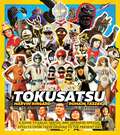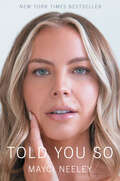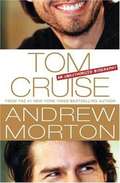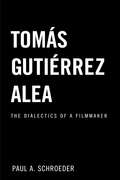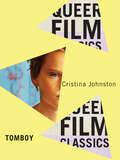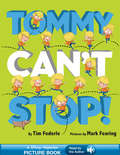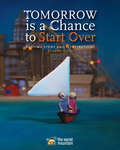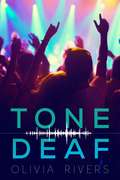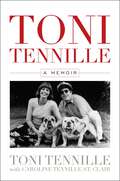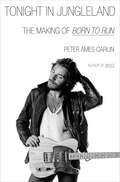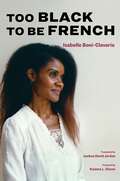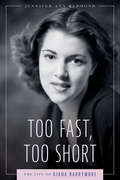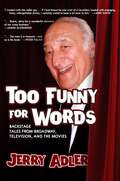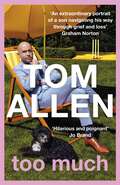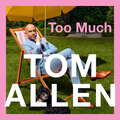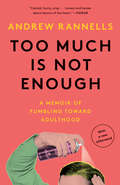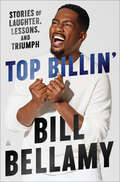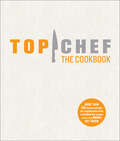- Table View
- List View
Tokusatsu
by Marvin RingardExplore the rich, decades-long history of all your favorite kaiju, super sentai, and more in this illustrated guide to the technical innovations, iconic aesthetics, and pop culture legacy of tokusatsu!Tokusatsu (which translates literally as &“special filming&”) is one of Japan&’s most beloved art forms. From kaiju such as Godzilla and Mothra to super sentai including the Power Rangers and Ultraman, tokusatsu has brought countless fan-favorite characters to life with its distinctive and groundbreaking special effects. Tokusatsu celebrates the medium&’s long and colorful history with lavish illustrations showcasing the eye-catching visuals of the genre—from terrifying monsters to giant robots and Lycra-clad superheroes. It examines the interplay of evolving technologies and Japanese culture from the 1950s to today, and there are biographies of legendary, genre-defining directors including Eiji Tsuburaya, Sonny Chiba, and Tohl Narita. Written by a passionate expert, this panoramic celebration has something special to offer die-hard tokusatsu fans, film and pop culture buffs, and the newly curious alike.
Tokyo Boogie-Woogie: Japan's Pop Era and Its Discontents
by Hiromu NagaharaEmerging in the 1920s, the Japanese pop scene gained a devoted following, and the soundscape of the next four decades became the audible symbol of changing times. In the first English-language history of this Japanese industry, Hiromu Nagahara connects the rise of mass entertainment with Japan’s transformation into a postwar middle-class society.
Told You So
by Mayci NeeleyFrom TikTok and The Secret Lives of Mormon Wives star Mayci Neeley, a deeply personal story of love, grief, motherhood, and resilience. Mayci Neeley and the women of MomTok burst into the center of pop culture when Hulu&’s The Secret Lives of Mormon Wives took the world by storm. But the show barely scratched the surface of Mayci&’s personal story. From becoming a mom at twenty, to losing her son&’s father in a tragic car accident, to going back to college as a single mother, she&’s only ever given us glimpses of the challenging things she&’s been through. Now, finally, she&’s ready to tell us everything. In this inspiring and darkly funny memoir, Mayci lifts the veil for readers on what growing up Mormon is really like and how it&’s strict standards completely blow up for many young people when they get to college. When Mayci arrived at BYU on a tennis scholarship, she was unprepared to manage the temptations she&’d been taught were sins. She found herself drinking too much, stuck in an abusive relationship, and on the verge of falling down a dark and dangerous path. Suddenly, she was pregnant at nineteen and mourning a boyfriend she&’d been building a future with. Mayci captures the period from college to adulthood with brutal honesty, grace, and humor, offering up a heartfelt portrait of a woman finding her voice and her strength. All of these trials led to her current love story, her journey with IVF, and of course the inside story of MomTok. Fans looking for a juicy play-by-play on the friend group drama will get everything they want—and then some—but more than anything, readers will walk away with a sense of confidence in themselves and an ability to wear their scars proudly.
Tom Cruise: An Unauthorized Biography
by Andrew MortonA riveting portrait of the real Tom Cruise - his work, love life, marriages and religion - from a master at uncovering the true story behind the public face of celebrity.
Tom Cruise: An Unauthorized Biography
by Andrew MortonAndrew Morton uncovers the true story of the biggest celebrity of our age. Everyone knows Tom Cruise—or at least what he wants us to know. We know that the man behind the smile overcame a tough childhood to star in astonishing array of blockbusters: Top Gun, Rain Man, Born on the Fourth of July, A Few Good Men, Jerry Maguire, several Mission: Impossible movies, and more. We know he has taken artistic chances, too, earning him three Academy Award and Golden Globe nominations. But beyond that, the picture becomes a bit less clear…We know that Tom is a devoted follower of the Church of Scientology. We know that, despite persistent rumors about his sexuality, he has been married to Mimi Rogers, Nicole Kidman, and Katie Holmes. But it was not until he jumped on Oprah's couch to proclaim his love for Katie and denounced Brooke Shields for turning to the "Nazi science" of psychiatry that we began to realize how much we did not know about the charming, hardworking star. For all the headlines and the rumors, the real Tom Cruise has remained surprisingly hidden—until now.
Tom Stoppard: A Life
by Hermione LeeOne of our most brilliant biographers takes on one of our greatest living playwrights, drawing on a wealth of new materials and on many conversations with himOne of our most brilliant biographers takes on one of our greatest living playwrights, drawing on a wealth of new materials and on many conversations with himTom Stoppard is a towering and beloved literary figure. Known for his dizzying narrative inventiveness and intense attention to language, he deftly deploys art, science, history, politics, and philosophy in works that span a remarkable spectrum of literary genres: theater, radio, film, TV, journalism, and fiction. His most acclaimed creations--Rosencrantz and Guildenstern are Dead, The Real Thing, Arcadia, The Coast of Utopia, Shakespeare in Love--remain as fresh and moving as when they entranced their first audiences.Born in Czechoslovakia, Stoppard escaped the Nazis with his mother and spent his early years in Singapore and India before arriving in England at age eight. Skipping university, he embarked on a brilliant career, becoming close friends over the years with an astonishing array of writers, actors, directors, musicians, and political figures, from Peter O'Toole, Harold Pinter, and Stephen Spielberg to Mick Jagger and Václav Havel. Having long described himself as a "bounced Czech," Stoppard only learned late in life of his mother's Jewish family and of the relatives he lost to the Holocaust.Lee's absorbing biography seamlessly weaves Stoppard's life and work together into a vivid, insightful, and always riveting portrait of a remarkable man.
Tomas Gutierrez Alea: The Dialectics of a Filmmaker
by Paul A. SchroederFirst Published in 2003. Routledge is an imprint of Taylor & Francis, an informa company.
Tomboy (Queer Film Classics)
by Cristina JohnstonCéline Sciamma’s 2011 film Tomboy is the central work in the French filmmaker’s coming-of-age trilogy. Bracketed between La Naissance des pieuvres / Waterlilies (2007), an examination of girlhood and teenage desire, and the 2014 film Bande de filles / Girlhood, about the lives of a group of Black girls in their late teens living in the Paris suburbs, Tomboy is a quiet, understated examination of gender and queer selfhood amidst the shifting sands of late childhood and early adolescence.Tomboy is an intimate and luminous film, tender but stark, and never sentimental. Written, cast, and filmed in a matter of months, it follows the experiences and burgeoning friendships of a ten-year-old child who moves to a new town during the summer holidays. First introducing themself as Mikaël, they are, we later learn, Laure to their parents and younger sister. Sciamma’s film is not interested in why the character is passing but in how. Cristina Johnston focuses on specific elements of Mikaël/Laure’s haptic and spatial experience, showing how the filmmaker’s signature engagement with surfaces and textures allows queer potentialities to unfold organically.While Johnston centres her analysis on Tomboy, she also connects the film to broader themes within Sciamma’s trilogy, public reception of the films, and the significance of Sciamma’s identity as a queer director. Ultimately the book offers insight into a film that deserves to be watched and appreciated for its nuanced portrayal of childhood, queerness, and passing as experience rather than ideology.
Tommy Can't Stop!: A Read-Along Book (Hyperion Picture Book with Audio (eBook))
by Tim FederleTommy bounces, and he leaps. Tommy clomps, and he bulldozes. Nothing tires Tommy out, and his family can't keep up! But then his sister has an idea: could tap class be just right for Tommy? This exuberant picture book, written by Broadway dancer Tim Federle, with illustrations by Mark Fearing, stars one very energetic kid who finally finds his place in the spotlight. Follow along with word-for-word narration.
Tommyland
by Tommy LeeI am Tommy Lee, born Thomas Lee Bass in Athens, Greece, on October 3, 1962, and raised in a suburb of California by an American father and a Greek mother. At seventeen, I joined Mötley Crüe and we became one of the baddest-ass rock bands in history. We sold over 40 million albums, we wreaked havoc, we scared parents, and we titillated too many fathers' daughters. I've been married three times: once for just a few days to a Penthouse Pet, for seven years to Heather Locklear, and then for five years to Pamela Anderson, with whom I have two beautiful sons. I've gotten into a lot of fights and I've been to jail a few times.But this book isn't your typical journey in a straight line from day one to day now. I'm more interested in revealing what's most important about my life, like how I cook my steaks; what I think of the tabloids, the truth, my ex-wives, my ex-band, my music; and what an innocent observer might find hanging around my house any given Sunday. You'll get plenty of facts and I'll tell you a story, but my real mission here is to paint you a picture of my life. I want to show you how my memories smell.I'd like to get into it now, so please take your seats. I advise you to keep your arms and legs inside the car at all times. If you have a pacemaker, a heart condition, or if you are pregnant or too damn short to reach the safety bar, I ask that you turn back immediately. Those with weak stomachs, strict morals, or chronic indigestion should put the book down now. For the rest of you, there's one truth that's real across the board: What you send out is what you get back. Send out the good, people, and it will come back to you. There's another thing I've learned over the years, in court, in fights, and in arguments with people I love: There isn't one truth, there are many. This book is my truth.NOTE: THE EBOOK DOES NOT INCLUDE PHOTOGRAPHS THAT APPEAR IN THE PRINT EDITIONS.
Tomorrow Is a Chance to Start Over
by Hilary GristWinner of:2015 National Association of Parenting Publications, Gold Award2015 Parents' Choice RecommendedNominee:2015 Canadian Folk Music Award, Best Children's AlbumA fresh, original project that will appeal to young parents who are fans of musical artists Feist or Norah Jones Ira and Isabelle, who live in a little red house by the sea, decide one night to escape the sound of the city's beeping cars and sail off to a faraway land where they learn from a new friend—a robin with a soft voice—that dreams really can come true. The book contains an audio CD that features the narrated story as well as 10 original heartwarming dream songs, and an ethereal rendition of Johannes Brahms' classic "Cradle Song."
Ton de Leeuw (Netherlands Music Archive #Vol. 1.)
by John Lydon Jurrien SligterFirst Published in 1996. Routledge is an imprint of Taylor & Francis, an informa company.
Tone Deaf
by Olivia RiversHis world is music. Her world is silent.Ali Collins was a child prodigy destined to become one of the greatest musicians of the twenty-first century-until she was diagnosed with a life-changing brain tumor. Now, at seventeen, Ali lives in a soundless world where she gets by with American Sign Language and lip-reading. She’s a constant disappointment to her father, a retired cop fighting his own demons, and the bruises are getting harder to hide.When Ali accidentally wins a backstage tour with the chart-topping band Tone Deaf, she’s swept back into the world of music. Jace Beckett, the nineteen-year-old lead singer of the band, has a reputation. He’s a jerk and a player, and Ali wants nothing to do with him. But there’s more to Jace than the tabloids let on. When Jace notices Ali’s bruises and offers to help her escape to New York, Ali can’t turn down the chance at freedom and a fresh start. Soon she’s traveling cross-country, hidden away in Jace’s RV as the band finishes their nationwide tour. With the help of Jace, Ali sets out to reboot her life and rediscover the music she once loved.
Toni Tennille: A Memoir
by Toni TennilleSince bursting onto the scene in the mid &‘70s, the pop duo Captain and Tennille have long defined the sparkling, optimistic idea of everlasting love, both in their music and through their image as a happy and, seemingly, unbreakable couple. They were an irresistible pair to millions of fans all over the world, further underscored by the rousing &“yes, we can!&” gospel of their biggest hit, &“Love Will Keep Us Together.&” But underneath the image was an entirely different story that the fans never saw: a woman who fought a lonely struggle against the controlling and often bizarre behavior of her emotionally inaccessible husband. Toni Tennille: A Memoir is a visceral account of Toni Tennille&’s life from her childhood in the segregated South to her thrilling rise to fame in the world of pop music to where she is now: no longer one-half of a famed couple, but a stronger woman for all she has experienced—both the good and the bad. Toni hopes that her story will help anyone who feels trapped in a toxic relationship realize that it is never too late to break away from it.
Tonight in Jungleland: The Making of Born to Run
by Peter Ames CarlinA fascinating behind-the-scenes account of the making of Bruce Springsteen’s ground-breaking album, Born to Run – one of the most iconic records in rock history – Tonight in Jungleland combines lush music writing with unprecedented inside access to Springsteen, his bandmates, and the full story behind every song… and coincides with the album’s 50th anniversary in August 2025. <p> From the opening piano notes of “Thunder Road,” to the final outro of “Jungleland” – with American anthems like “Born to Run” and “Tenth Avenue Freeze Out” in between – Bruce Springsteen’s seminal album, Born to Run, established Springsteen as a creative force in rock and roll. With his back against the wall, he wrote what has been hailed as a perfect album, a defining moment, and a roadmap for what would become a legendary career. <p> Peter Ames Carlin, whose bestselling biography, Bruce, gave him rare access to Springsteen’s inner circle, now returns with the full story of the making of this epic album. Released in August, 1975, Born to Run now celebrates its 50th anniversary. Carlin reveals a treasure trove of untold stories, detailing the writing and recording of every song, as well as the intense and at times tortuous process that mimicked the fault lines in Springsteen’s psyche and career, even as it revealed the depth of his vision. A must-read for any music fan, Tonight in Jungleland takes us inside a hallowed creative process and lets us experience history. <p> <b>New York Times Bestseller</b>
Too Black to Be French
by Isabelle Boni-ClaverieWinner, Grand Prize, French Voices Award In Too Black to Be French, Isabelle Boni-Claverie navigates the complexities of identity, race, and family in a world that constantly questions her belonging. Boni-Claverie's singular account interweaves the extraordinary life experiences of three generations of her family: her grandfather from Ivory Coast, who married a middle-class white woman from southern France in the 1930s; her biological parents, and her mixed-race aunt and white upper-class uncle who adopted her; as well as her own life as a successful film director and writer faced with abiding stereotypes and discrimination.Written with humor and aplomb, Boni-Claverie’s narrative examines the enduring effects of France’s colonial past and the deep-seated structural prejudices affecting Black people in a country that prides itself on stories of its hospitality toward African Americans fleeing segregation. Updating this picture to reveal the complexities and challenges of being Black in France where discussion of race is often taboo, Boni-Claverie offers an American readership rare insights into racial dynamics on both sides of the Atlantic. Too Black to Be French is at once a sociological portrait of France, a multicultural family album, and a transatlantic coming-of-age story. It will appeal to readers eager for a passionate fresh voice devoted to better understanding the challenges of today’s world and the courage it takes to overcome them. Through vivid storytelling, Boni-Claverie invites readers to traverse a path filled with emotional depth, cultural introspection, and a quest for acceptance.
Too Fast, Too Short: The Life of Diana Barrymore (Hollywood Legends Series)
by Jennifer Ann RedmondAmerican actress and socialite Diana Barrymore (1921–1960) was a figure often overshadowed by her famous lineage and tragic narrative. In Too Fast, Too Short: The Life of Diana Barrymore, author Jennifer Ann Redmond illuminates Barrymore’s complex world, revealing a woman caught between the glittering facade of Hollywood and the dark shadows of her personal struggles. That she was the confused, neglected daughter of legendary actor John Barrymore is common knowledge. Just as central to Barrymore’s story is the profound influence of her mother, poet/playwright Michael Strange. Both distant and domineering, Strange’s contradictory nature stifled Barrymore and her siblings, thrusting her into a socialite world she neither desired nor understood. Barrymore’s familial relationships were marked by pain and complexity. Her older brother, Leonard, was detached, and the golden child brother, Robin, who lived openly as a gay man in an era of secrecy, died by suicide after the death of his lover, Billy Rambo. Barrymore’s later years were colored by her relationship with the iconic playwright Tennessee Williams. Viewing Williams as the gateway to her dreams of a successful career, a happy marriage, and motherhood, Barrymore’s interactions with him reveal her vulnerability and resilience. Unpublished correspondence with mutual friends sheds light on her aspirations and the poignant desperation of her delusions. This biography endeavors to present Diana Barrymore not as a cautionary tale but as a complex individual. Volatile, bristly, and unreliable, yet also clever, funny, and profoundly intelligent, Barrymore was a woman of remarkable talent and beauty, even if she rarely saw it herself. Through this volume, Barrymore emerges as a fully realized person, reclaiming her place in Hollywood’s history.
Too Funny for Words: Backstage Tales from Broadway, Television, and the Movies
by Jerry AdlerThis must read is your golden ticket to a trip down memory lane with of one of Hollywood's most iconic actors. . .Who almost turned down his iconic role on The Sopranos because he could not sing? Did Katharine Hepburn really build the Uris building? How did a simple handshake with President Kennedy almost end in disaster? In his debut memoir, Too Funny for Words, Jerry Adler reveals all for the first time! In his career as a theater director, producer, and actor that has spanned over 70 years, Adler has certainly had his fair share of laughs, and is ready to take readers on a reminiscent journey of Hollywood tales past. With numerous stories to tell, each funnier than the last, sit back and enjoy a trip behind the scenes. Including unforgettable stories about: Paul Rudd, Robin Williams, Meryl Streep, Larry David, James Gandolfini, Alan Arkin, Woody Allen, JFK, Marilyn Monroe, Barbra Streisand, Joe Pesci, Paul Reiser, George Clooney, Richard Burton, Richard M. Nixon, Katharine Hepburn, Julie Andrews, Orson Welles, and many, many more!
Too Much
by Tom Allen'An extraordinary portrait of a son navigating his way through grief and loss in real time. Funny, candid, and measured' GRAHAM NORTONHappily settled in a new relationship and with a dream house of his own, comedian Tom Allen had finally moved on from the arrested development of millennial life and could at last call himself an adult.But when his father died suddenly in late 2021, Tom's newfound independence was rocked by a fresh set of challenges, and he began to find solace in the past (and his new vegetable patch). Told through snapshots from Tom's busy life - whether reflecting on the campness of funeral customs, muddy lockdown walks in unsuitable footwear or just reminiscing on his childhood obsession with Patricia Routledge - Too Much is a hilarious joyride of stories as well as an emotional ode to Tom's beloved dad, and a touching manifesto on how to navigate the complexities of grief. With moving honesty and wit, Tom writes beautifully about those days, weeks and months following his family's loss, and about how bewildering the practicalities of life can be in the wake of an upheaval - those moments, really, when everything can start to feel a bit too much...'Hilarious and poignant' JO BRAND
Too Much
by Tom Allen'An extraordinary portrait of a son navigating his way through grief and loss in real time. Funny, candid, and measured' GRAHAM NORTONHappily settled in a new relationship and with a dream house of his own, comedian Tom Allen had finally moved on from the arrested development of millennial life and could at last call himself an adult.But when his father died suddenly in late 2021, Tom's newfound independence was rocked by a fresh set of challenges, and he began to find solace in the past (and his new vegetable patch). Told through snapshots from Tom's busy life - whether reflecting on the campness of funeral customs, muddy lockdown walks in unsuitable footwear or just reminiscing on his childhood obsession with Patricia Routledge - Too Much is a hilarious joyride of stories as well as an emotional ode to Tom's beloved dad, and a touching manifesto on how to navigate the complexities of grief. With moving honesty and wit, Tom writes beautifully about those days, weeks and months following his family's loss, and about how bewildering the practicalities of life can be in the wake of an upheaval - those moments, really, when everything can start to feel a bit too much...'Hilarious and poignant' JO BRAND
Too Much
by Tom Allen'An extraordinary portrait of a son navigating his way through grief and loss in real time. Funny, candid, and measured' GRAHAM NORTONHappily settled in a new relationship and with a dream house of his own, comedian Tom Allen had finally moved on from the arrested development of millennial life and could at last call himself an adult.But when his father died suddenly in late 2021, Tom's newfound independence was rocked by a fresh set of challenges, and he began to find solace in the past (and his new vegetable patch). Told through snapshots from Tom's busy life - whether reflecting on the campness of funeral customs, muddy lockdown walks in unsuitable footwear or just reminiscing on his childhood obsession with Patricia Routledge - Too Much is a hilarious joyride of stories as well as an emotional ode to Tom's beloved dad, and a touching manifesto on how to navigate the complexities of grief.With moving honesty and wit, Tom writes beautifully about those days, weeks and months following his family's loss, and about how bewildering the practicalities of life can be in the wake of an upheaval - those moments, really, when everything can start to feel a bit too much...'Hilarious and poignant' JO BRAND
Too Much Is Not Enough: A Memoir of Fumbling Toward Adulthood
by Andrew RannellsFrom the star of Broadway's The Book of Mormon and HBO's Girls, the heartfelt and hilarious coming-of-age memoir of a Midwestern boy surviving bad auditions, bad relationships, and some really bad highlights as he chases his dreams in New York CityWhen Andrew Rannells left Nebraska for New York City in 1997, he, like many young hopefuls, saw the city as a chance to break free. To start over. To transform the fiercely ambitious but sexually confused teenager he saw in the mirror into the Broadway leading man of his dreams.In Too Much Is Not Enough, Rannells takes us on the journey of a twentysomething hungry to experience everything New York has to offer: new friends, wild nights, great art, standing ovations. At the heart of his hunger lies a powerful drive to reconcile the boy he was when he left Omaha with the man he desperately wants to be.As Rannells fumbles his way towards the Great White Way, he also shares the drama of failed auditions and behind-the-curtain romances, the heartbreak of losing his father at the height of his struggle, and the exhilaration of making his Broadway debut in Hairspray at the age of twenty-six. Along the way, he learns that you never really leave your past—or your family—behind; that the most painful, and perversely motivating, jobs are the ones you almost get; and that sometimes the most memorable nights with friends are marked not by the trendy club you danced at but by the recap over diner food afterward.Honest and hilarious, Too Much Is Not Enough is an unforgettable look at love, loss, and the powerful forces that determine who we become.
Top Billin': Stories of Laughter, Lessons, and Triumph
by Bill BellamyFrom the MTV trailblazer, stand-up comedian, and actor, a hilariously candid memoir that is an intimate, entertaining, and heartfelt tour through the exclusive, elusive, and eternally iconic world of ’90s pop culture.Imagine 50 Cent’s Hustle Harder, Hustle Smarter written by a nerdy Black kid from Newark, New Jersey, who made it big despite the skepticism of his family. That’s Top Billin'.Bill Bellamy is Carlton Banks’s slightly cooler and comedically inclined alter-ego—a guy who went against the grain and left a promising corporate career path to pursue comedy (much to the dismay of his family). Making the leap paid off—in ways Bill never expected. In Top Billin', he looks back at his time at MTV during the ’90s, when the cable music channel was at the epicenter of pop culture. He recounts his legendary interviews with the biggest pop stars—Tupac, Biggie, and Kurt Cobain—making friends with Janet Jackson, and even coining the infamous term “booty call” on HBO’s Def Comedy Jam. During his time at MTV, Bill broke color and class barriers, appearing four times a week on the network’s various programs, including MTV Jamz and MTV Beach House.Top Billin' is an exclusive, all-access backstage pass to Bill’s career and life. It’s all in here—memories, music, and unforgettable moments, including conversations with some of the decade’s legendary artists, the best of the ’90s celebri-tea, nostalgia, and insights on what it meant to be a tastemaker during one of the most exciting and innovative periods in music and American pop culture history.
Top Chef: The Cookbook
by Bravo MediaThe creators of Bravo’s Top Chef share inside stories and more than 100 recipes in this New York Times bestselling cookbook and series companion.In Top Chef: The Cookbook, Tom Colicchio invites fans and home chefs into the hottest kitchen on prime time. This volume features some of the most memorable winning recipes from the first three seasons, as well as dishes from the Elimination Rounds and the Quick-Fire Challenges. Here you’ll find Elia Aboumrad’s Breakfast, Lunch, and Dinner Waffles; C.J. Jacobson’s Crepes; Hung Huynh’s Tuna Tartare; Lea Anne Wong’s Deep Fried Oysters; Tre Wilcox III’s Bacon wrapped Shrimp; and much more.In-depth discussions with contestants, judges, and crew reveal the inner workings of the show, and lavish photographs take readers behind-the-scenes into the Top Chef pantry and competition sites. This cookbook will have aspiring culinary contenders reliving classic show moments and relishing new recipes!
